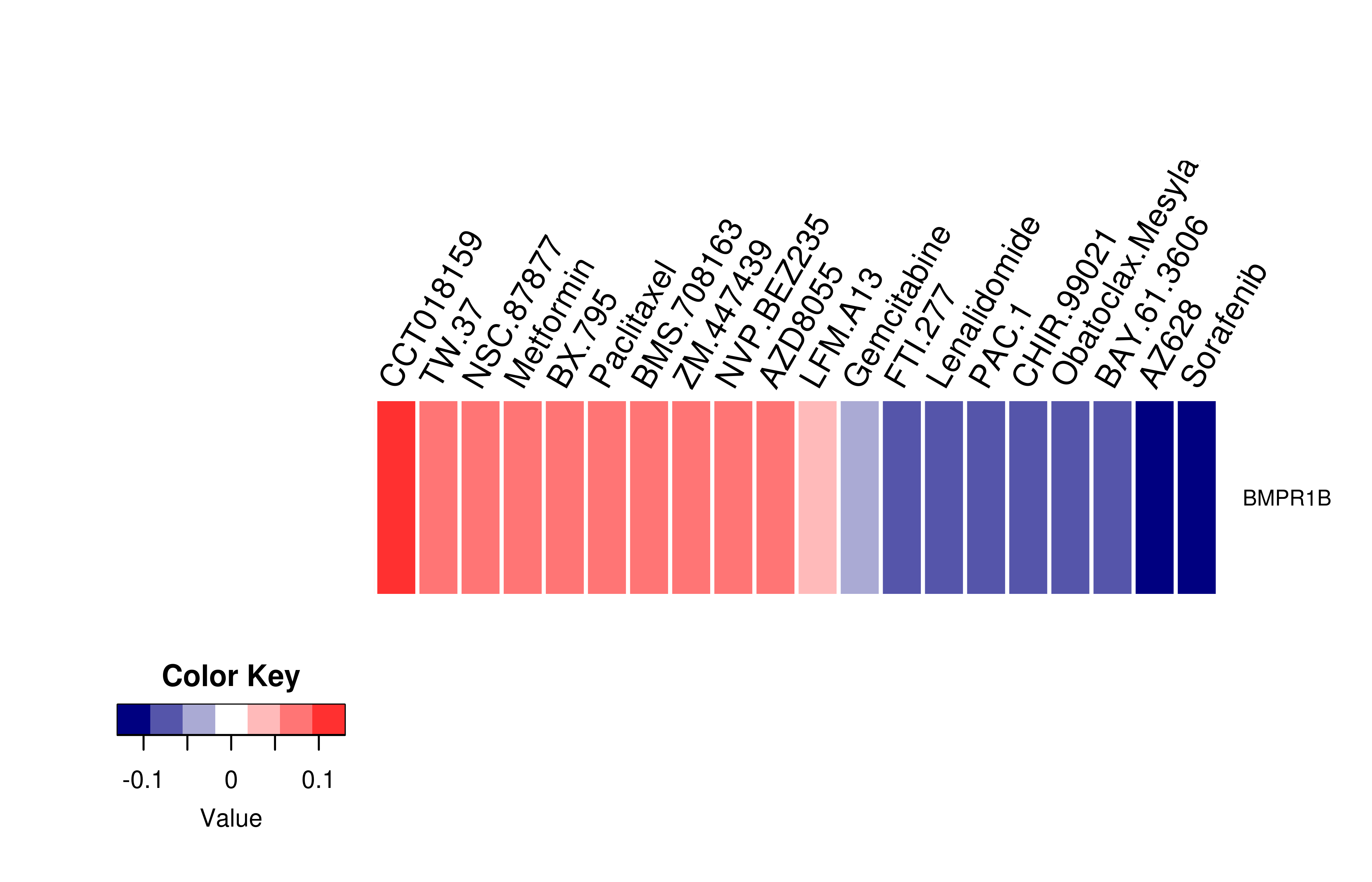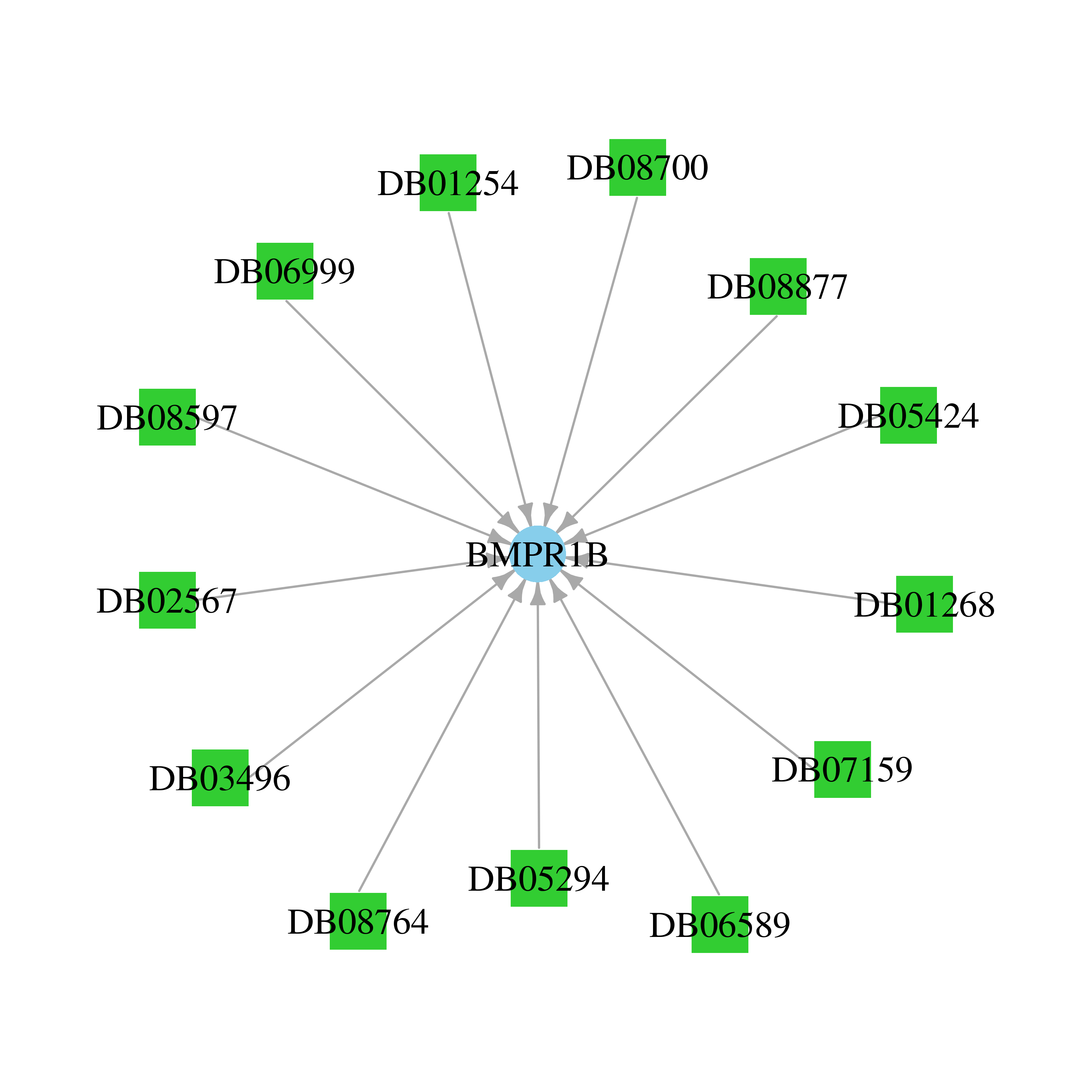|
mutLBSgeneDB |
| |
| |
| |
| |
| |
| |
|
| Gene summary for BMPR1B |
 Gene summary Gene summary |
| Basic gene Info. | Gene symbol | BMPR1B |
| Gene name | bone morphogenetic protein receptor, type IB | |
| Synonyms | ALK-6|ALK6|CDw293 | |
| Cytomap | UCSC genome browser: 4q22-q24 | |
| Type of gene | protein-coding | |
| RefGenes | NM_001203.2, NM_001256792.1,NM_001256793.1,NM_001256794.1, | |
| Description | BMP type-1B receptorBMPR-1Bactivin receptor-like kinase 6bone morphogenetic protein receptor type-1Bserine/threonine receptor kinase | |
| Modification date | 20141207 | |
| dbXrefs | MIM : 603248 | |
| HGNC : HGNC | ||
| Ensembl : ENSG00000138696 | ||
| HPRD : 04457 | ||
| Vega : OTTHUMG00000130991 | ||
| Protein | UniProt: O00238 go to UniProt's Cross Reference DB Table | |
| Expression | CleanEX: HS_BMPR1B | |
| BioGPS: 658 | ||
| Pathway | NCI Pathway Interaction Database: BMPR1B | |
| KEGG: BMPR1B | ||
| REACTOME: BMPR1B | ||
| Pathway Commons: BMPR1B | ||
| Context | iHOP: BMPR1B | |
| ligand binding site mutation search in PubMed: BMPR1B | ||
| UCL Cancer Institute: BMPR1B | ||
| Assigned class in mutLBSgeneDB | A: This gene has a literature evidence and it belongs to targetable_mutLBSgenes. | |
| References showing study about ligand binding site mutation for BMPR1B. | 1. "Demirhan O, Türkmen S, Schwabe GC, Soyupak S, Akgül E, Tastemir D, Karahan D, Mundlos S, Lehmann K. A homozygous BMPR1B mutation causes a new subtype of acromesomelic chondrodysplasia with genital anomalies. J Med Genet. 2005 Apr;42(4):314-7. PubMed PMID: 15805157; PubMed Central PMCID: PMC1736042. " 15805157 2. "Graul-Neumann LM, Deichsel A, Wille U, Kakar N, Koll R, Bassir C, Ahmad J, Cormier-Daire V, Mundlos S, Kubisch C, Borck G, Klopocki E, Mueller TD, Doelken SC, Seemann P. Homozygous missense and nonsense mutations in BMPR1B cause acromesomelic chondrodysplasia-type Grebe. Eur J Hum Genet. 2014 Jun;22(6):726-33. doi: 10.1038/ejhg.2013.222. Epub 2013 Oct 16. PubMed PMID:24129431; PubMed Central PMCID: PMC4023204." 24129431 3. "Stange K, Désir J, Kakar N, Mueller TD, Budde BS, Gordon CT, Horn D, Seemann P, Borck G. A hypomorphic BMPR1B mutation causes du Pan acromesomelic dysplasia. Orphanet J Rare Dis. 2015 Jun 24;10:84. doi: 10.1186/s13023-015-0299-5. PubMed PMID: 26105076; PubMed Central PMCID: PMC4482310. " 26105076 | |
 Gene ontology having evidence of Inferred from Direct Assay (IDA) from Entrez Gene ontology having evidence of Inferred from Direct Assay (IDA) from Entrez |
| GO ID | GO Term | PubMed ID | GO:0006468 | protein phosphorylation | 12065756 | GO:0030509 | BMP signaling pathway | 18436533 |
| Top |
| Ligand binding site mutations for BMPR1B |
 Cancer type specific mutLBS sorted by frequency Cancer type specific mutLBS sorted by frequency |
| LBS | AAchange of nsSNV | Cancer type | # samples | I210 | G211E | BLCA | 1 | V218 | W219C | LUAD | 1 | T279 | T279I | UCEC | 1 | D350 | L351M | UCEC | 1 |
| cf) Cancer type abbreviation. BLCA: Bladder urothelial carcinoma, BRCA: Breast invasive carcinoma, CESC: Cervical squamous cell carcinoma and endocervical adenocarcinoma, COAD: Colon adenocarcinoma, GBM: Glioblastoma multiforme, LGG: Brain lower grade glioma, HNSC: Head and neck squamous cell carcinoma, KICH: Kidney chromophobe, KIRC: Kidney renal clear cell carcinoma, KIRP: Kidney renal papillary cell carcinoma, LAML: Acute myeloid leukemia, LUAD: Lung adenocarcinoma, LUSC: Lung squamous cell carcinoma, OV: Ovarian serous cystadenocarcinoma, PAAD: Pancreatic adenocarcinoma, PRAD: Prostate adenocarcinoma, SKCM: Skin cutaneous melanoma, STAD: Stomach adenocarcinoma, THCA: Thyroid carcinoma, UCEC: Uterine corpus endometrial carcinoma. |
| Top |
| Protein structure related information for BMPR1B |
 Relative protein structure stability change (ΔΔE) using Mupro 1.1 Relative protein structure stability change (ΔΔE) using Mupro 1.1 Mupro score denotes assessment of the effect of mutations on thermodynamic stability. (ΔΔE<0: mutation decreases stability, ΔΔE>0: mutation increases stability) |
 : nsSNV at non-LBS : nsSNV at non-LBS : nsSNV at LBS : nsSNV at LBS |
 |
 nsSNVs sorted by the relative stability change of protein structure by each mutation nsSNVs sorted by the relative stability change of protein structure by each mutation Blue: mutations of positive stability change. and red : the most recurrent mutation for this gene. |
| LBS | AAchange of nsSNV | Relative stability change | D350 | L351M | 0.21828383 | V218 | W219C | -0.86842069 | I210 | G211E | -0.83251587 | T279 | T279I | -0.58910467 |
| (MuPro1.1: Jianlin Cheng et al., Prediction of Protein Stability Changes for Single-Site Mutations Using Support Vector Machines, PROTEINS: Structure, Function, and Bioinformatics. 2006, 62:1125-1132) |
 Structure image for BMPR1B from PDB Structure image for BMPR1B from PDB |
| Top |
| Differential gene expression and gene-gene network for BMPR1B |
 Differential gene expression between mutated and non-mutated LBS samples in all 16 major cancer types Differential gene expression between mutated and non-mutated LBS samples in all 16 major cancer types |
 Differential co-expressed gene network based on protein-protein interaction data (CePIN) Differential co-expressed gene network based on protein-protein interaction data (CePIN) |
| Top |
| Top |
| Phenotype information for BMPR1B |
 Gene level disease information (DisGeNet) Gene level disease information (DisGeNet) |
| Disease ID | Disease name | # PubMed | Association type |
| umls:C1832702 | Brachydactyly type A2 | 6 | Biomarker, GeneticVariation |
| umls:C0033578 | Prostatic Neoplasms | 2 | AlteredExpression, Biomarker |
| umls:C1836182 | Chondrodysplasia, acromesomelic, with genital anomalies | 1 | Biomarker, GeneticVariation |
| umls:C0005941 | Bone Diseases, Developmental | 1 | Biomarker |
| umls:C0376634 | Craniofacial Abnormalities | 1 | Biomarker |
| umls:C0015393 | Eye Abnormalities | 1 | Biomarker |
| umls:C0031117 | Peripheral Nervous System Diseases | 1 | Biomarker |
 Mutation level pathogenic information (ClinVar annotation) Mutation level pathogenic information (ClinVar annotation) |
| Allele ID | AA change | Clinical significance | Origin | Phenotype IDs |
| Top |
| Pharmacological information for BMPR1B |
 Gene expression profile of anticancer drug treated cell-lines (CCLE) Gene expression profile of anticancer drug treated cell-lines (CCLE)Heatmap showing the correlation between gene expression and drug response across all the cell-lines. We chose the top 20 among 138 drugs.We used Pearson's correlation coefficient. |
 |
 Gene-centered drug-gene interaction network Gene-centered drug-gene interaction network |
 |
 Drug information targeting mutLBSgene (Approved drugs only) Drug information targeting mutLBSgene (Approved drugs only) |
| Drug status | DrugBank ID | Name | Type | Drug structure |
 Gene-centered ligand-gene interaction network Gene-centered ligand-gene interaction network |
 |
 Ligands binding to mutated ligand binding site of BMPR1B go to BioLip Ligands binding to mutated ligand binding site of BMPR1B go to BioLip |
| Ligand ID | Ligand short name | Ligand long name | PDB ID | PDB name | mutLBS | LDN | 4-[6-(4-PIPERAZIN-1-YLPHENYL)PYRAZOLO[1,5-A]PYRIMIDIN-3-YL]QUINOLINE | 3mdy | A | I210 V218 T279 D350 | LDN | 4-[6-(4-PIPERAZIN-1-YLPHENYL)PYRAZOLO[1,5-A]PYRIMIDIN-3-YL]QUINOLINE | 3mdy | C | I210 V218 T279 D350 |
| Top |
| Conservation information for LBS of BMPR1B |
 Multiple alignments for O00238 in multiple species Multiple alignments for O00238 in multiple species |
| LBS | AA sequence | # species | Species | A229 | RGEKVAVKVFF | 3 | Homo sapiens, Gallus gallus, Mus musculus | A229 | RGSYVAVKTFY | 1 | Caenorhabditis elegans | A349 | GTCCIADLGLA | 3 | Homo sapiens, Gallus gallus, Mus musculus | A349 | NVCCIADLGLA | 1 | Caenorhabditis elegans | D280 | LYLITDYHENG | 3 | Homo sapiens, Gallus gallus, Mus musculus | D280 | MLLITDYHELG | 1 | Caenorhabditis elegans | D289 | NGSLYDYL-KS | 3 | Homo sapiens, Gallus gallus, Mus musculus | D289 | LGSLSDYLCRE | 1 | Caenorhabditis elegans | D350 | TCCIADLGLAV | 3 | Homo sapiens, Gallus gallus, Mus musculus | D350 | VCCIADLGLAL | 1 | Caenorhabditis elegans | E283 | ITDYHENGSLY | 3 | Homo sapiens, Gallus gallus, Mus musculus | E283 | ITDYHELGSLS | 1 | Caenorhabditis elegans | G285 | DYHENGSLYDY | 3 | Homo sapiens, Gallus gallus, Mus musculus | G285 | DYHELGSLSDY | 1 | Caenorhabditis elegans | H282 | LITDYHENGSL | 3 | Homo sapiens, Gallus gallus, Mus musculus | H282 | LITDYHELGSL | 1 | Caenorhabditis elegans | I210 | QMVKQIGKGRY | 3 | Homo sapiens, Gallus gallus, Mus musculus | I210 | TIIKTIGQGRY | 1 | Caenorhabditis elegans | K336 | RDLKSKNILVK | 3 | Homo sapiens, Gallus gallus, Mus musculus | K336 | RDIKSKNIIVK | 1 | Caenorhabditis elegans | L259 | RHENILGFIAA | 3 | Homo sapiens, Gallus gallus, Mus musculus | L259 | NHENILQFVAA | 1 | Caenorhabditis elegans | L339 | KSKNILVKKNG | 3 | Homo sapiens, Gallus gallus, Mus musculus | L339 | KSKNIIVKRPN | 1 | Caenorhabditis elegans | N337 | DLKSKNILVKK | 3 | Homo sapiens, Gallus gallus, Mus musculus | N337 | DIKSKNIIVKR | 1 | Caenorhabditis elegans | T279 | QLYLITDYHEN | 3 | Homo sapiens, Gallus gallus, Mus musculus | T279 | KMLLITDYHEL | 1 | Caenorhabditis elegans | V218 | GRYGEVWMGKW | 3 | Homo sapiens, Gallus gallus, Mus musculus | V218 | GRYGEVRKALY | 1 | Caenorhabditis elegans | Y281 | YLITDYHENGS | 3 | Homo sapiens, Gallus gallus, Mus musculus | Y281 | LLITDYHELGS | 1 | Caenorhabditis elegans |
 |
Copyright © 2016-Present - The University of Texas Health Science Center at Houston |
